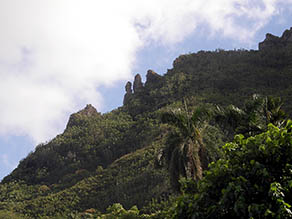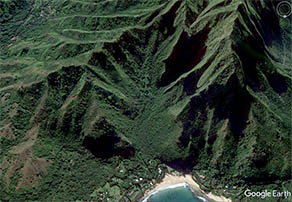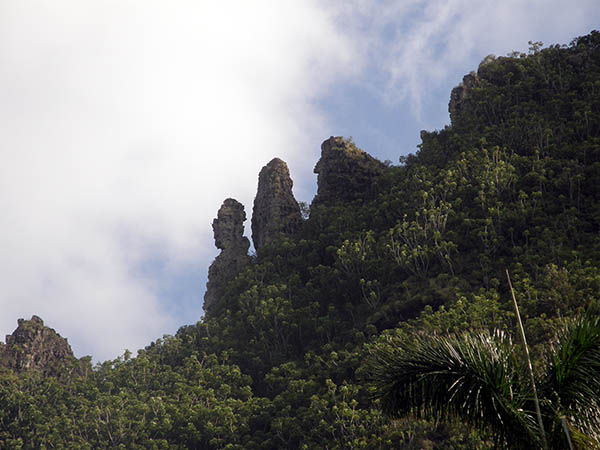 |
“Na-piliwale, ‘clinging ones,’ a stone formation on the Mānoa ridge, looks like two running figures with their skirts flying up behind them,” writes Uncle Bruce. “They had prodigious appetites and their favorite foods were the freshwater shrimp, the wī, freshwater snails, and the fiddlehead of the fern hō‘i‘o. Two of these sisters came to Hā‘ena for a visit."
“The Piliwale sisters are a good example,” Carlos says. “Their arrival and presence in any land heralded a time of famine. It was their custom to visit the courts of different ali‘i, lingering there in luxury until they had eaten all of the food in the area. Lōhi‘au and his sister, Kahuanui, decided to end the depredations of these dangerous women. They knew the Piliwale sisters had one weakness: if the rays of the sun touched them, they would turn to stone.

Hō‘i‘o.
“When the sisters came to Hā‘ena, Lōhi‘au and Kahuanui, as Hawaiian protocol demands, invited the sisters to a feast and celebration of the hula that had been prepared especially for them. Their favorite foods were offered them in great quantities. These included ōpae (freshwater shrimp), hō‘i‘o (edible upland fern shoots), and wī (freshwater limpets), all still delicacies of the land.
“The skilled performers of Kē‘ē entertained the sisters in a hālau, a large thatched hall built high up on the ridge above Maniniholo cave especially for the occasion. They draped the open sides of the house with mats, ostensibly to protect the participants from the cool night winds. At sunrise, after a night of revelry when eyelids were heavily burdened by sleep, Kahuanui quickly pulled up the mats, startling the heavily sated sisters.

The Piliwale sisters on the ridge above Limahuli Valley.
"Sensing the fatal rays of the sun, they bolted from the party. The two predatory females ran frantically, stumbling down the precipice toward the cave in order to hide from the deadly effects of the sun. But the piercing dawn caught the panicked sisters halfway down the ridge, where they stand to this day."
“Piliwale means clinging. Ho‘opili mea ‘ai, a difficult-to-translate derogatory remark made by Hawaiian speakers today, alludes to people who hang around the merely to eat your food or who seem to show up often at mealtime, but are never there when work is necessary or help is needed.”
“They always overstayed their welcome in places,” Lahela adds. “So the village and areas where they always went, it’s like ‘Oh my gosh, how do we get rid of them?’ They have to figure it out.

A large hale (house) at Limahuli Gardens. Photo by Dawn Niederhauser.
“Well, they have to be out from the sunlight. And so the village put on an amazing, amazing feast for them. They built a house and on the inside they had shades to drop, so that no can see on the outside. And of course the Piliwale sisters are just loving it—I would be loving it too!—and eating, and they don’t realize that it’s becoming daylight. And so when they realize, they’re trying to run back. So if you look above the cave that’s where they were staying. You can see the sisters, the lumps over there like running down to the cave—and they turned into stone!
“And the mana‘o of the story is, Don’t overstay your welcome. Be gracious of what is given, not try eat everything that’s there, to me it’s that don’t overstay your welcome or overtake. Don’t be greedy.”
Related Storied Places
“Three geographic features in Hā‘ena are named after kānaka Hawai‘i (Hawaiian people) turned to stone by Menehune for stealing food,” Carlos says. “Kea‘alewalewa, a thief and mischief-maker, stands as a peak forming part of the boundary between Wainiha, a neighboring district, and Hā‘ena."

GoogleEarth image of Manoa Valley. Kea‘alewalewa is on the left ridge.
Ke-a‘a-lewalewa, ‘dangling root,’ is a peak on the east side of Mānoa Valley," adds Uncle Bruce. "A‘a lewalewa are the aerial roots of the ‘ohi‘a lehua tree of the forests or the pandanus tree of the lowlands. Kea‘alewalewa was a Wainiha man who constantly stole food from the Menehune farmers in Mānoa Valley. They got so angry after a time that they chased after him and turned him to stone. The name conveys the connotation of ‘dangling,’ and thus indicates that he was doing more than stealing food.
“Another Hawaiian man and his wife used to steal from the fields of the Menehune farmers in Mānoa Valley. The Menehune finally chased after the two with intent to get rid of them once and for all. They chased the wife into Limahuli Valley. Near the waterfall, she had to stop for she was too tired to run farther. She was out of breath and sat gasping. The Menehune caught her there and killed her. She was turned to stone and is called Naenae, ‘congested.’ The man was chased up the ridge toward Pohaku-a-Kāne. He was frightened, but he was very strong—as well as twice the size of the Menehune—and he put up a strong fight. The Menehune used their slingshots and pelted him with stones. Some of these were so large that the bones of his skull were shattered and stuck up through the scalp. In this form he turned to stone, and the ridge where he lies was named Ka-iwi-ku‘i, ‘hammered bone.’”

"Naenae and her husband Ka‘iwiku‘i are also both memorialized in stone in that area," Carlos adds. "'Naenae' means short of breath. Menehune caught her first during a pursuit directed at both her and her husband, most likely because of this physical shortcoming. Transformed into a triangular furrowed stone at the head of Limahuli valley, she was shortly thereafter joined by her husband in the same fate. The stronger Ka‘iwiku‘i, an expert in the bone-breaking Hawaiian martial art of lua, caught later in the chase, put up quite a fight when captured by his pursuers. They crushed his skull and broke his bones, transforming him into a rock described as a pōhaku winiwini (sharp rock) in the chronicles."
“These stories hint at what the traditional values of the people in Hā‘ena might have been. Those who lacked a means of exchange, those who would not provide their own food, and those who clung to others for support were looked upon unfavorably, and people how actually plundered gardens and plantings of others were often dealt with severely....Memorialized in stone, these stories constantly remind emerging generations of Hā‘ena people about the negative consequences of laziness, rude behavior, and stealing from one another."
|
 |
























